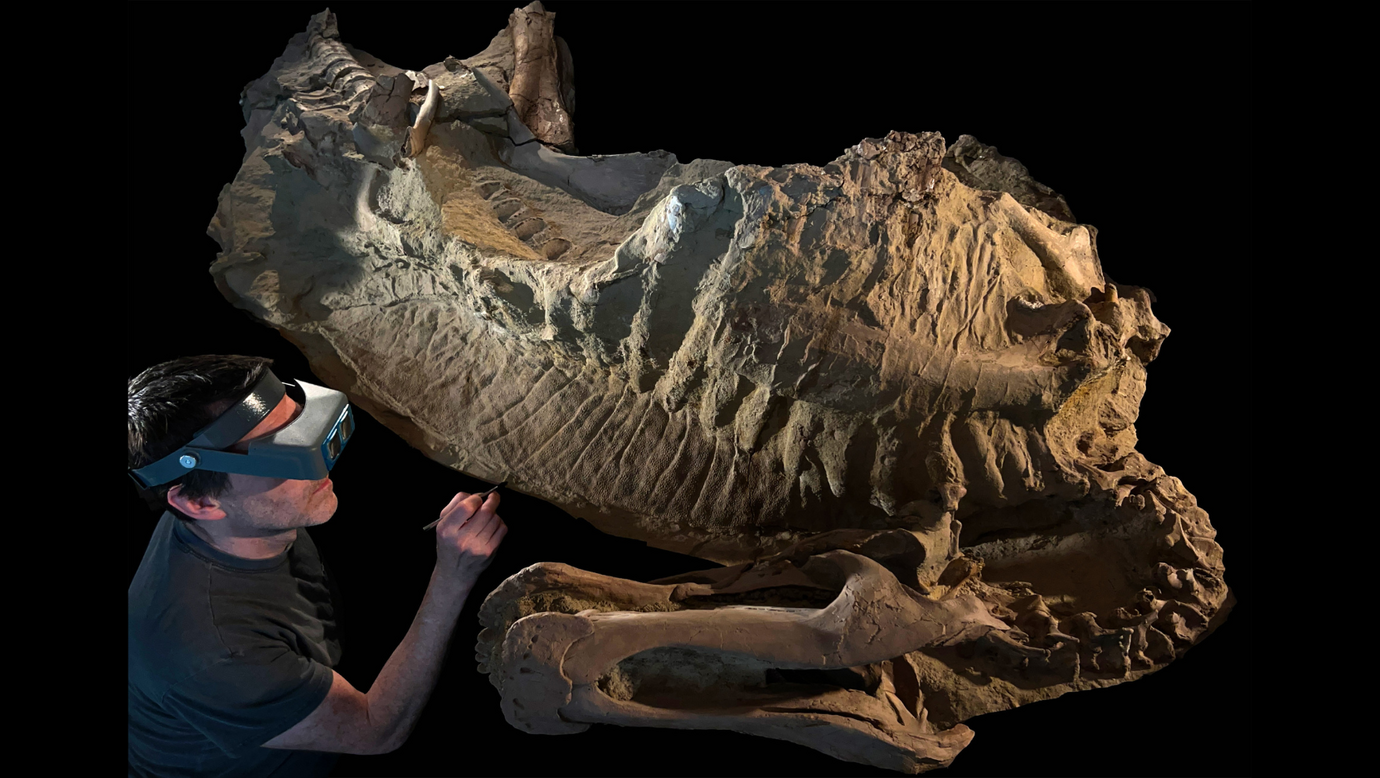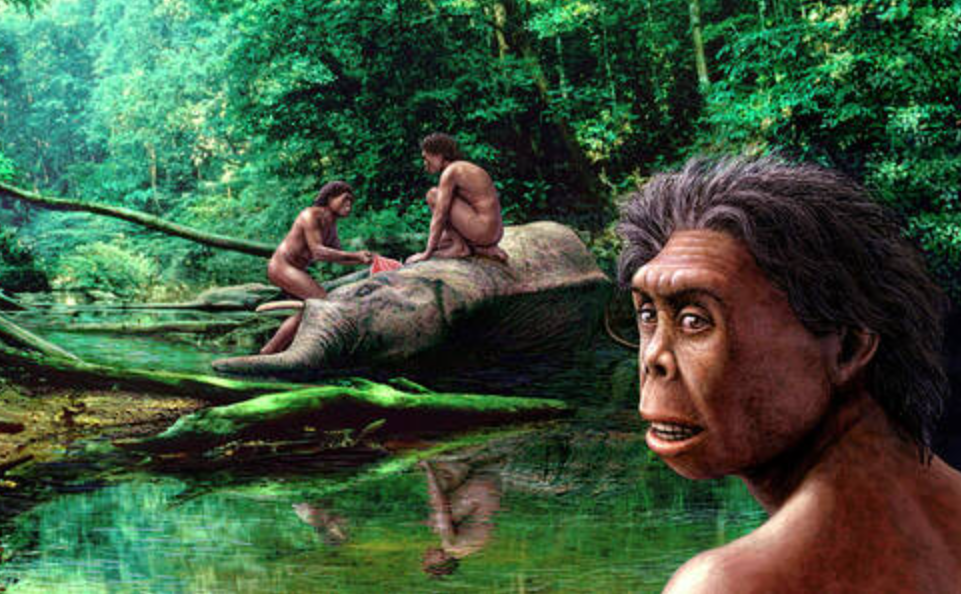Scientists discover first-ever hooved dinosaur in Wyoming’s ‘Mummy Zone’
A Wyoming dig has revealed the first hooved dinosaur, Edmontosaurus annectens, and solved the mystery of how dinosaur “mummies” form.

 Edited By: Joseph Shavit
Edited By: Joseph Shavit

Mummy of the juvenile duck-billed dinosaur Edmontosaurus annectens with fossil preparator Tyler Keillor of the University of Chicago. (CREDIT: UChicago Fossil Lab)
Long before horses thundered across the plains, a plant-eating giant with hooves of its own left footprints in the mud. Newly described fossils of Edmontosaurus annectens—a duck-billed dinosaur that roamed North America 66 million years ago—show that this gentle giant had flexible skin crests, rows of tail spikes, and, most surprisingly, true hooves.
Researchers from the University of Chicago have reconstructed the dinosaur’s outer appearance using two remarkably preserved “mummies” unearthed in Wyoming’s Lance Formation. Their findings, published in Science, not only redraw the look of this Cretaceous herbivore but also solve a century-old mystery of how such lifelike fossils formed.
Rediscovering the Mummy Zone
Paleontologist Paul Sereno and his team returned to a region nicknamed the “mummy zone,” where well-preserved Edmontosaurus fossils were first found in the early 1900s. By combining historic photos, field maps, and modern imaging, they pinpointed the exact layers of river sand and mud that entombed the ancient creatures.
In that compact area—less than ten kilometers wide—the team uncovered two new specimens: a late juvenile about two years old and a young adult roughly five to eight years old. Both retained large stretches of fossilized external surface, each covered in an ultra-thin film of clay no thicker than a sheet of paper.
Sereno emphasizes that these dinosaurs were not “mummified” in the traditional sense. “This is a mask, a template, a clay layer so thin you could blow it away,” he said. The clay, rich in minerals such as kaolinite, formed when a bacterial film coating the carcass attracted charged clay particles from surrounding sediment. The layer hardened into a delicate shell that captured every wrinkle, scale, and spike before the flesh itself decayed.
A Crest of Flesh and a Row of Spikes
With modern tools—including hospital CT scanners and high-resolution 3D imaging—the researchers recreated the animal’s fleshy contours. The most striking feature was a soft crest rising over the neck and back, much like the ridge on an iguana but smoother and taller. In the younger specimen, the crest stood about 17 centimeters high; scaled up to adult size, it could have reached nearly a foot tall.
The crest’s surface was covered in small polygonal scales arranged in neat bands that followed the vertebrae. Over the hips, the structure merged into a single row of interlocking spikes running the full length of the tail. Each spike overlapped the next, forming a shingled ridge that likely caught the light and gave the dinosaur a striking profile as it moved through its floodplain habitat.
Hooves Instead of Claws
What astonished the team most were the feet. CT scans showed that the hind toes were capped by wedge-shaped hooves rather than claws. The largest, on the middle toe, measured more than 15 centimeters long and bore the same downward-angled surface and shallow depression seen in horse hooves. Fine striations along the outer surface confirmed their structure.
The researchers matched the shape of these hooves to fossilized footprints from the same region and age. The three broad toe impressions with deep creases perfectly fit the reconstructed feet. The evidence shows Edmontosaurus walked in a “subunguligrade” posture—balanced on flat hoof bases rather than claw tips.
Its front feet were built differently. They carried a single main hoof and a broad pad behind it, supporting an “unguligrade” stance where weight rested on the hoof tip. That combination—tip-toed forelimbs and flatter hind limbs—has no match among living hoofed animals today.
“There are so many amazing ‘firsts’ preserved in these duck-billed mummies—the earliest hooves documented in a land vertebrate, the first confirmed hooved reptile, and the first four-legged animal with different front and back limb postures,” Sereno said.
Rewriting How “Mummies” Form
For decades, paleontologists believed dinosaur “mummies” formed when dry skin toughened in open air before burial. The Wyoming finds overturn that view. The team’s analysis shows the skin never survived; instead, the outer surface was recorded as a clay mold only a fraction of a millimeter thick.
As the carcass decayed underground, gases created empty spaces within the skin and spikes. Clay and sand infiltrated those voids, forming a three-dimensional cast that hardened before the tissues dissolved. This process—called “clay templating”—was known from marine fossils but had never been demonstrated in land animals until now.
“It’s the first time we’ve had a complete, fleshed-out view of a large dinosaur that we can really feel confident about,” Sereno said. “The badlands in Wyoming are a unique mummy zone that still holds more surprises.”
A Full-Body Portrait
The two mummies complemented each other perfectly, allowing the team to see an entire body outline for the first time. The skin showed short, sharp wrinkles over the ribs and larger scales under the tail, indicating thin but flexible hide.
Digital artists worked alongside scientists to produce detailed reconstructions of the living animal—an impressive 40-foot grazer with a ridged back, a spiked tail, and hooves designed for long walks through muddy floodplains.
Fossil Lab manager Tyler Keillor led the painstaking work of exposing the fragile clay boundary. Each stroke of the brush risked blowing away the fossil’s “skin.” Meanwhile, postdoctoral scholar Evan Saitta analyzed sediment samples and CT data to match the mummified feet to real footprints, confirming how the dinosaur’s limbs functioned in life.
From Field Puzzle to New Science
The research doesn’t stop at anatomy. The study introduces new vocabulary for describing fossilized skin, replacing misleading terms like “mummy” and “skin impression” with “integument rendering.” It also outlines a full workflow—from field collection to 3D digital reconstruction—that future teams can use to study soft tissues in extinct species.
Beyond rewriting textbooks, the work opens new possibilities for understanding how climate and chemistry interact to preserve life forms in exceptional detail. The same clay templating process that immortalized Edmontosaurus may yet explain other mysterious fossils found across ancient riverbeds.
Sereno calls the project his “tour de force.” “From field to lab to 3D reconstructions along with a suite of useful terms defined,” he said, “it tells a coherent story about how these remarkable fossils come to be and what we can learn from them.”
Practical Implications of the Research
The discovery reshapes how scientists—and the public—visualize dinosaurs. By revealing the first known hooved reptile, it expands the evolutionary picture of how walking styles and limb postures developed long before mammals evolved hooves. It also provides a scientific foundation for future biomechanical models, allowing researchers to simulate movement with unprecedented accuracy.
More broadly, the study establishes a model for fossil preservation that may help identify other “mummy zones” around the world.
Understanding clay templating could guide paleontologists to new sites where soft-tissue details lie waiting in stone, preserving the textures of ancient life down to the millimeter.
Research findings are available online in the journal Science.
Related Stories
- Dinosaurs thrived until the end: New Mexico fossils rewrite extinction story
- Mongolian fossil fills 15-million-year gap in dinosaur behavior and evolution
- Triumphant return of 'living dinosaur' to Big Stone Lake in Minnesota
Like these kind of feel good stories? Get The Brighter Side of News' newsletter.
Joshua Shavit
Science & Technology Writer and Editor
Joshua Shavit is a Los Angeles-based science and technology writer with a passion for exploring the breakthroughs shaping the future. As a co-founder of The Brighter Side of News, he focuses on positive and transformative advancements in AI, technology, physics, engineering, robotics and space science. Joshua is currently working towards a Bachelor of Science in Business and Industrial Engineering at the University of California, Berkeley. He combines his academic background with a talent for storytelling, making complex scientific discoveries engaging and accessible. His work highlights the innovators behind the ideas, bringing readers closer to the people driving progress.



